Table of Contents
What is a Comma?
A comma is a punctuation mark that separates parts of a sentence to make it clearer and easier to read.
Example Sentences:
She bought apples, bananas, and oranges.
After the meeting, we went to lunch.
He said, Yes, I agree.
How to Use a Comma
Commas are used to:
- Separating Items in a List
- Before Conjunctions in Compound Sentences
- After Introductory Phrases or Clauses
- Setting Off Non-Essential Information
- Separating Coordinate Adjectives
- Before a Quotation
- In Dates and Addresses
- To Avoid Confusion
- Before Direct Address
- To Separate Contrasting Elements
- In Numbers (for clarity)
- With Transitional Phrases
Using Commas in Different Situations
Commas with but
When but joins two complete sentences, a comma is placed before but to connect them properly.
- I wanted to go outside, but it started raining.
In this sentence, I wanted to go outside and it started raining are two independent clauses. The comma before but makes the sentence flow naturally.
Commas with and
When using and to join two independent clauses, a comma is placed before and to make the sentence clear.
- He studied all night, and he passed the exam.
Both He studied all night and he passed the exam are complete ideas, so a comma before and keeps them linked smoothly.
Avoiding comma splices
A common mistake is joining two independent clauses with just a comma, without using and or but. This is called a comma splice.
- Incorrect: She loves coffee, she drinks it every day.
To fix this, add and or use a period. - Correct: She loves coffee, and she drinks it every day.
The two ideas are now connected correctly.
Commas with relative clauses
When giving extra information about a noun, we use commas around the additional clause if the information is not essential to the sentence.
- My brother, who lives in London, is visiting us next week.
Here, who lives in London is extra information about my brother. The sentence would still make sense without it, so commas are necessary.
Commas with appositives
An appositive is a word or phrase that provides more information about a noun.
- Mr. Smith, our math teacher, explained the lesson well.
Our math teacher is extra information about Mr. Smith, so commas are used to set off the appositive.
Commas with introductory phrases
When a sentence begins with a phrase that introduces the main action, a comma follows that phrase.
- After the movie, we went out for dinner.
The introductory phrase After the movie is separated from the main idea with a comma to avoid confusion.
Commas with dates
When writing dates, commas separate the day from the year.
- She was born on August 5, 1998.
The comma helps distinguish the date parts, making it easier to read.
Commas with coordinate adjectives
When two or more adjectives equally describe a noun, use commas between them.
- It was a cold, windy, and dark night.
Each adjective describes night equally, so commas separate them clearly.
Use of comma to separate nouns (subjects/objects)
Commas are used when listing multiple subjects or objects in a sentence.
- Mary, John, and Alice went to the park.
The comma separates each subject to make the sentence easy to follow.
Use of comma to separate two phrases / a phrase and a clause
When separating two phrases or a phrase from a clause, commas are used to ensure clarity.
- We visited the museum, but it was closed.
In this sentence, the phrase We visited the museum and the clause it was closed are connected with but and separated by a comma.
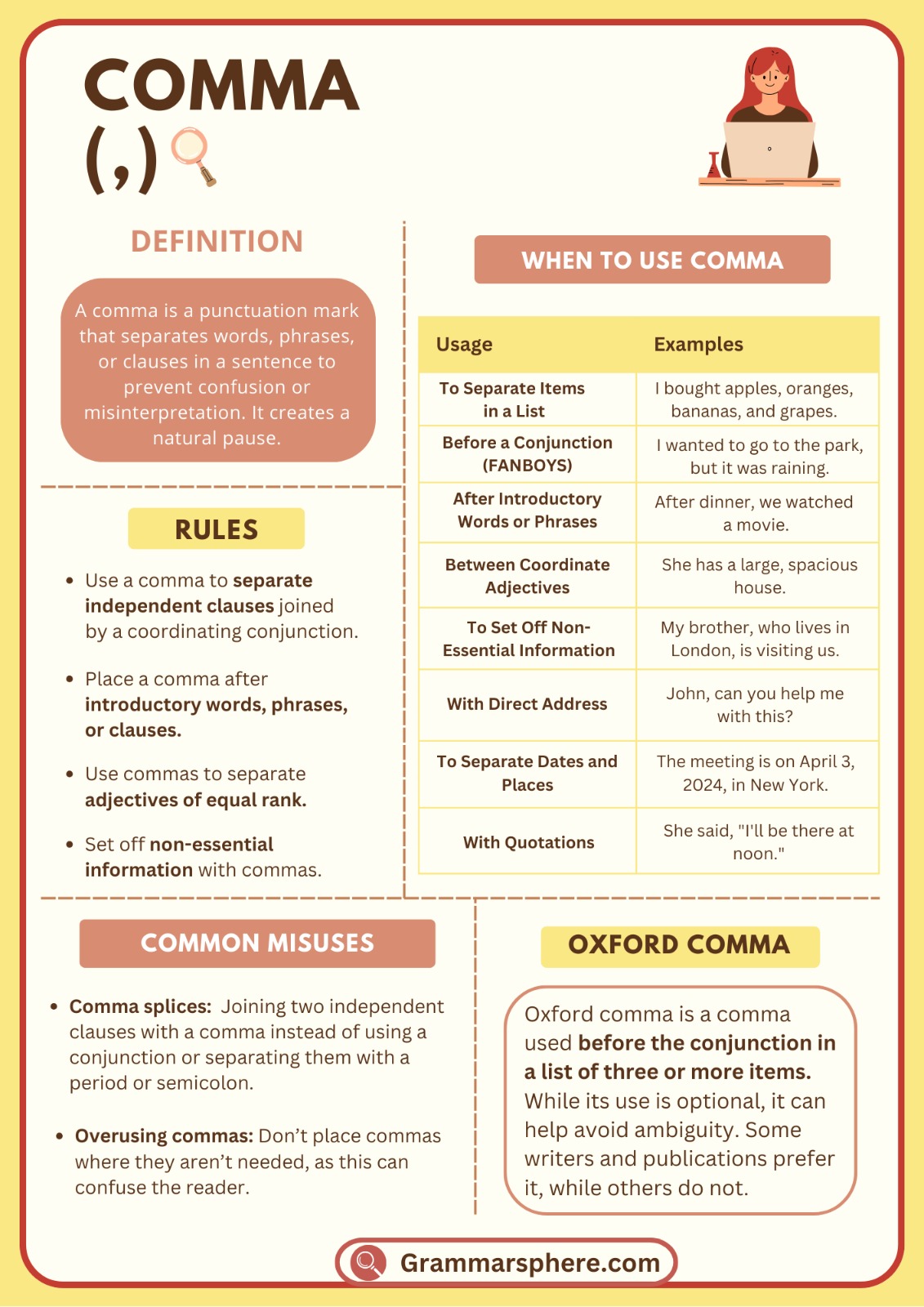
Commas with Transitional Phrases
Transitional phrases are words or groups of words that help connect ideas or show relationships between sentences and clauses. When using these phrases, it’s important to place a comma before and/or after them to enhance clarity and flow in writing.
Here are some common transitional phrases and how to use commas with them:
1. Beginning a Sentence
When a transitional phrase starts a sentence, a comma should follow it.
However, we decided to stay home.
In this case, However introduces a contrasting idea, and the comma indicates a pause before the main clause.
2. In the Middle of a Sentence
When a transitional phrase appears in the middle of a sentence, use commas before and after the phrase to separate it from the rest of the sentence.
We were, therefore, unable to attend the meeting.
Here, therefore is set off by commas, indicating that it adds additional information.
3. At the End of a Sentence
When a transitional phrase appears at the end of a sentence, use a comma before it if it’s part of a longer sentence, and it indicates a contrast or a conclusion.
We wanted to leave early; we stayed late, nonetheless.
In this sentence, nonetheless is placed at the end and separated by a comma to show that it contrasts with the previous idea.
Common Transitional Phrases
- However
- Therefore
- Moreover
- Consequently
- On the other hand
- In addition
- Furthermore
- Nevertheless
Rules for Using Commas
1. Commas with conjunctions like but and and
When but or and connect two complete sentences, place a comma before the conjunction. This helps separate the two independent ideas for clarity.
- I wanted to go outside, but it started raining.
In this example, I wanted to go outside and it started raining are both complete sentences. The comma before but keeps the ideas connected smoothly.
- She studied hard, and she passed the test.
Both clauses here are complete thoughts, so a comma before and is necessary.
2. Commas with introductory phrases
When a sentence begins with an introductory word or phrase, use a comma after it to separate it from the main sentence. This helps guide the reader to the main action.
- After the meeting, we went out for dinner.
Here, After the meeting is an introductory phrase that leads into the main clause. The comma after the phrase makes it clear.
- Once the sun set, the air became cooler.
In this sentence, the introductory phrase Once the sun set is separated from the rest of the sentence by a comma.
3. Commas with non-essential information
When adding extra, non-essential details about a noun, use commas to set off that information. This is common with relative clauses or appositives, where the additional information is not needed to understand the main point of the sentence.
- My brother, who lives in New York, is visiting next week.
The clause who lives in New York gives extra information about my brother, but the sentence would still make sense without it. Therefore, commas are necessary.
- The Eiffel Tower, a famous landmark, attracts millions of visitors.
Here, a famous landmark is non-essential information about The Eiffel Tower, so commas are used to set it off.
4. Commas in lists
When listing three or more items in a sentence, place a comma between each item to make the list clearer. The final comma before and (called the Oxford comma) is optional but often recommended for clarity.
- We need bread, milk, eggs, and butter.
Each item in the list is separated by a comma, ensuring the reader understands each part.
- The colors of the flag are red, white, and blue.
The commas separate each color clearly.
5. Commas with coordinate adjectives
When using two or more adjectives that equally describe a noun, use commas to separate them. If you can place and between the adjectives without changing the meaning, they are coordinate adjectives and need commas.
- It was a cold, windy, rainy day.
Each adjective describes the day equally, so commas are needed.
- She wore a long, elegant dress.
Long and elegant equally describe the dress, so a comma is used between them.
6. Commas with dates
When writing dates, use commas to separate the day from the year.
- She was born on July 15, 1995.
The comma separates the day July 15 from the year 1995, making the date easier to read.
- On October 12, 2024, we will celebrate her birthday.
Here, the comma separates the day and year, and another comma separates the date from the rest of the sentence.
7. Commas with appositives
An appositive is a noun or noun phrase that provides additional information about another noun. Use commas to set off appositives when the information is not essential to the meaning of the sentence.
- My friend Sarah, a brilliant artist, won the award.
Here, a brilliant artist gives extra information about Sarah. The sentence would still make sense without it, so commas are necessary.
- The author, J.K. Rowling, is known for her famous book series.
J.K. Rowling is an appositive that adds detail about The author.
8. Commas with addresses
When writing addresses, use commas to separate parts of the address.
- We moved to 123 Oak Street, Dallas, Texas.
The commas separate the street, city, and state to make the address clearer.
- Their office is located at 456 Maple Avenue, New York, NY.
The address is broken down with commas between each part.
9. Commas to separate phrases and clauses
When a sentence contains more than one phrase or clause, use commas to separate them, especially when the ideas are different or there is a shift in the sentence.
- We wanted to go for a walk, but it was raining.
The comma separates the two ideas, making the sentence easier to read.
- If it rains, we will stay inside.
The comma separates the conditional phrase If it rains from the main action we will stay inside.
10. Commas with direct speech or quotes
When writing direct speech, use a comma before the quotation or dialogue.
- He said, You can come to the party.
The comma after He said separates the reporting verb from the quoted speech.
- I replied, Thank you for the invitation.
The comma separates the verb I replied from the speech Thank you for the invitation.
Use of Comma to Separate Nouns (Subjects/Objects)
When you have two or more subjects or objects in a sentence, commas help separate them clearly. This avoids confusion and helps the reader understand the sentence better.
For example, if you have a sentence with multiple subjects:
- John, Sarah, and Mark went to the park.
In this case, the comma separates John, Sarah, and Mark, making it clear that all three people are subjects of the action went to the park.
Similarly, when dealing with multiple objects, commas can help:
- She bought apples, oranges, and bananas.
Here, apples, oranges, and bananas are objects of the verb bought. The commas separate these items, ensuring each is clearly identified.
Without commas, the sentence could be confusing, as the reader may not know where one noun ends and the next begins.
Using Comma to Split Two Phrases / A Phrase and A Clause
When you combine two phrases or a phrase and a clause in one sentence, a comma can separate them for clarity and flow.
Take this example where two phrases are joined:
- The cat sat on the windowsill, watching the birds fly by.
Here, the first phrase The cat sat on the windowsill is separated from the second phrase watching the birds fly by by a comma. This makes it clear that both ideas are related but separate actions happening at the same time.
When separating a phrase and a clause, the comma plays a similar role:
- After the rain stopped, we went outside to play.
The introductory phrase After the rain stopped is separated from the main clause we went outside to play. Without the comma, the sentence might be harder to follow because the transition between the ideas wouldn’t be as clear.
In both cases, commas help to ensure that the sentence flows naturally and that the reader can easily understand each part.
Using Comma to Split a Main Clause from a Subordinate Clause
When a subordinate clause (which cannot stand alone as a sentence) comes before or after the main clause (which can stand alone as a complete sentence), a comma is often used to separate them. This ensures clarity and helps the reader identify where one idea ends and the next begins.
Subordinate Clause Before the Main Clause:
When the subordinate clause comes at the beginning of a sentence, a comma is needed to separate it from the main clause.
- Although it was raining, we went for a walk.
In this sentence, Although it was raining is the subordinate clause that gives extra information. The comma separates it from the main clause we went for a walk, making the sentence easier to understand.
The comma after the subordinate clause helps to clearly mark the transition to the main idea of the sentence. Without the comma, the sentence would be harder to follow.
Subordinate Clause After the Main Clause:
When the subordinate clause comes after the main clause, a comma is usually not needed unless the subordinate clause adds non-essential information or causes a pause.
- We went for a walk although it was raining.
Here, We went for a walk is the main clause, and although it was raining is the subordinate clause. In this case, no comma is needed because the sentence flows naturally.
The main clause is clear on its own, and the subordinate clause comes after it without needing extra separation. However, if the subordinate clause introduces a pause or emphasis, a comma may be added.
- If you study hard, you will pass the exam.
If you study hard is the subordinate clause, and you will pass the exam is the main clause. The comma ensures that the reader pauses slightly before moving on to the main idea of the sentence.
- You will pass the exam if you study hard.
Since the subordinate clause comes at the end, no comma is needed. The sentence flows directly from the main clause to the subordinate clause.
In short, when the subordinate clause comes before the main clause, use a comma to separate them. If the subordinate clause follows the main clause, a comma is generally not needed unless there’s a pause or non-essential information.
Common Mistakes
1. Comma Splices
A comma splice occurs when two complete sentences are incorrectly joined by just a comma without a coordinating conjunction (and, but, or).
✖️ He loves to read, he doesn’t have time for it.
Here, two complete sentences are joined only by a comma, which is incorrect.
✔️ He loves to read, but he doesn’t have time for it.
By adding but, the two independent clauses are properly joined.
✖️ She was tired, she went to bed early.
✔️ She was tired, so she went to bed early.
In this case, the conjunction so correctly connects the two ideas.
2. Missing Comma After Introductory Phrases
Failing to place a comma after an introductory phrase can lead to confusion.
✖️ After dinner we watched a movie.
The lack of a comma can make it hard to identify the main action.
✔️ After dinner, we watched a movie.
The comma helps separate the introductory phrase from the main clause.
✖️While I was sleeping my phone rang.
✔️ While I was sleeping, my phone rang.
Adding a comma clarifies the sentence structure.
3. Unnecessary Comma Before the Conjunction
Some writers mistakenly place a comma before a conjunction when it connects two items.
✖️ I bought apples, and oranges.
The comma before and is unnecessary since there are only two items.
✔️ I bought apples and oranges.
No comma is needed here as there are only two items being listed.
✖️ We can go to the park, or the beach.
✔️ We can go to the park or the beach.
Again, the comma is not needed with just two choices.
4. Incorrect Use of Commas with Non-Essential Information
Commas should be used correctly around non-essential information.
✖️ My brother who lives in New York is visiting.
The sentence incorrectly lacks commas around the non-essential clause.
✔️ My brother, who lives in New York, is visiting.
The commas indicate that the clause is additional information.
✖️ The car that is parked outside belongs to me.
✔️ The car, which is parked outside, belongs to me.
Using commas correctly clarifies that the information is non-essential.
5. Using Commas in a Series Without the Oxford Comma
Some writers skip the final comma in a list, which can lead to ambiguity.
✖️ I love hiking, swimming and biking.
Without the final comma, it’s unclear if swimming and biking is a combined activity or two separate ones.
✔️ I love hiking, swimming, and biking.
Using the Oxford comma clarifies that these are three distinct activities.
✖️ For breakfast, I had eggs, toast and jam.
✔️ For breakfast, I had eggs, toast, and jam.
Including the final comma helps to maintain clarity in the list.
Conclusion
Commas are an essential part of punctuation, and mastering them will help you write more clearly and effectively. By learning these rules and practicing them, you can avoid common mistakes and improve your communication skills. Start practicing today, and soon using commas will become second nature!
You May Also Like


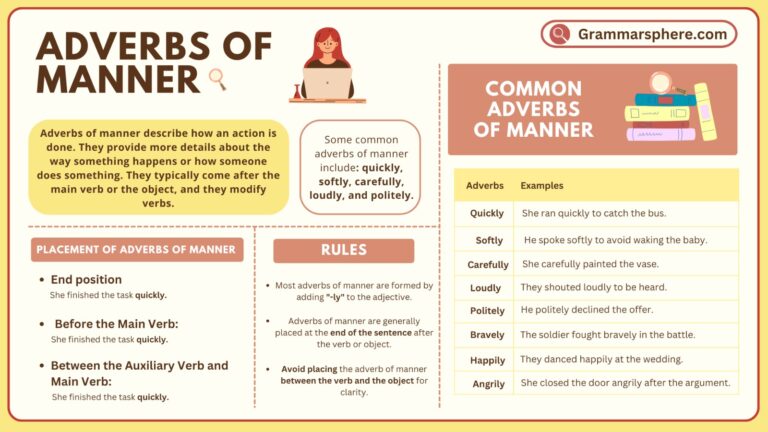
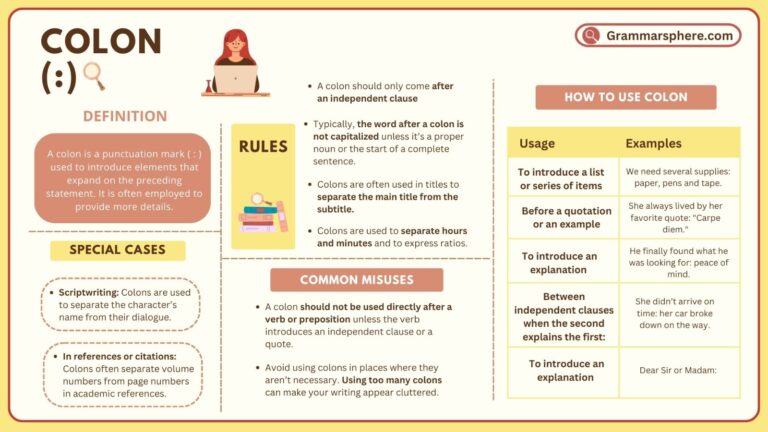
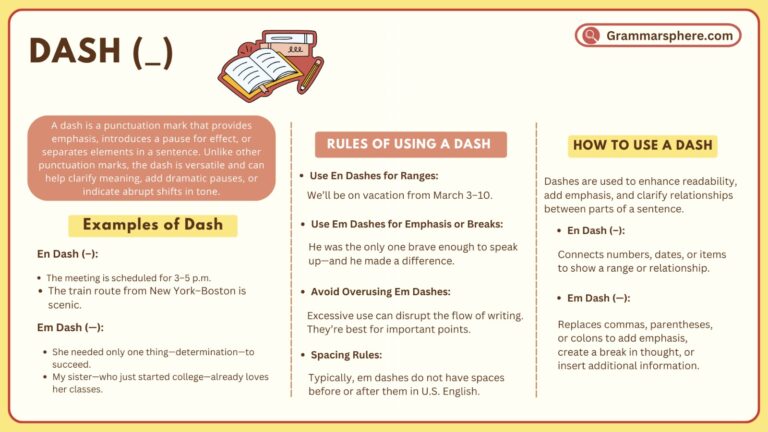
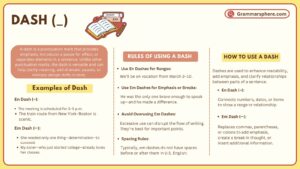


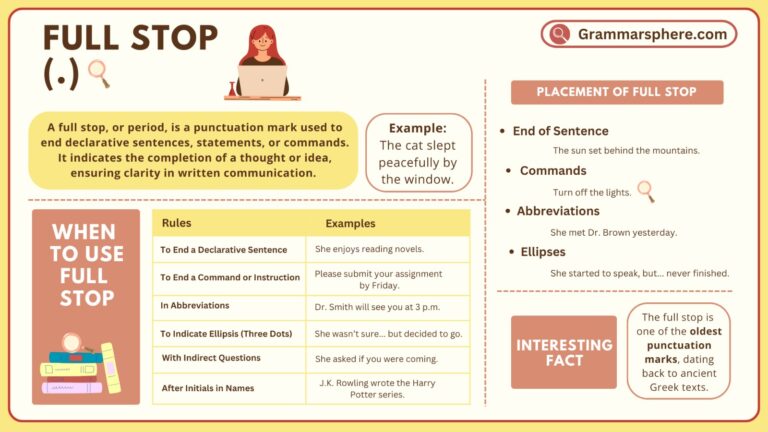
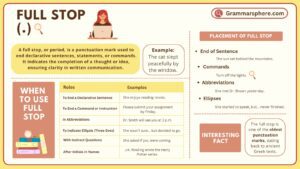
Leave a Comment